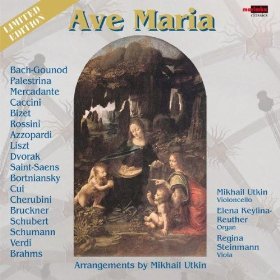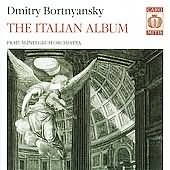Ave Maria
Composer: Dmytro Stepanowitch Bortniansky (1751-1825), 1775
Alternate Names/Transliterations:
Дмитро Степанович Бортнянський, Dmytro Stepanovych Bortnians’kyi, Дмитрий
Степанович Бортнянский, Dmitrij Stepanovič Bortnjanskij, Dmitrii Stepanovich
Bortnianskii, Dmitry Stepanovich Bortniansky, Dmitri Stepanowitsch Bortnjanski
 |

page |
(Ukrainian) |
|

AveWiki link |

|
X |
X |
X |
 |
 |
|
Dmytro |
|
Bortniansky |
|
1751 |
1825 |
|
1775 |
|
|
Ave Maria |
|
|
 |
 |
 |
X |
X |
|
Dmytro |
|
Bortniansky |
|
1751 |
1825 |
|
1775 |
|
|
Ave
plena gratia |
SATB |
a cappella |

| Recordings: |
|
 |
CD: Ave
Maria - arrangements by Mikhail Utkin
tr12. Ave
Maria: Ave Maria by Dimitri Bortniansky
tr13.
Ave Maria: Benedicta by
Dimitri Bortniansky
tr14. Ave Maria:
Sancta Maria by Dimitri Bortniansky
|
|
 |
CD:
Dmitry Bortnyansky - The Italian Album /
Pratum Integrum Orchestra
tr12. Ave Maria: Ave Maria
by Dimitri Bortniansky
tr13.
Ave Maria: Benedicta by
Dimitri Bortniansky
tr14. Ave Maria:
Sancta Maria by Dimitri Bortniansky
|
| MIDI / Lyrics: not
available |
| Score: not available |


| Internet references,
biography information. |
|
https://en.wikipedia.org/wiki/Dmitry_Bortniansky |
Dmitry Stepanovich Bortniansky (Russian:
Дмитрий Степанович Бортнянский; alternative transcriptions of names are
Dmitri and Bortnyansky; 28 October 1751–10 October [O.S. 28 September]
1825)[1] was a Russian[2] composer of Ukrainian[3] origin.
Bortniansky is best known today for his liturgical works and his prolific
contributions to the genre of choral concertos.[4] He was one of the "Golden
Three" of his era, along with Artemy Vedel and Maksym Berezovsky.
Bortniansky composed in many different musical styles, including choral
compositions in French, Italian, Latin, German and Church Slavonic.
Biography
Student
Dmitry Bortniansky was born on 28 October 1751 in the city of Hlukhiv (the
present-day Ukraine), then a part of the autonomous Cossack Hetmanate within
the Russian Empire (as Glukhov), into the family of Stefan Skurat (or
Shkurat), a Lemko-Rusyn Orthodox religious refugee from the village of
Bortne in the Malopolska region (he was entered in the Cossack register of
Glukhov in 1755).[5] At the age of seven, Dmitry's prodigious talent at the
local church choir afforded him the opportunity to go the capital of the
empire and sing with the Imperial Chapel Choir in St. Petersburg. There he
studied music and composition under the director of the Imperial Chapel
Choir, the Italian master Baldassare Galuppi. When Galuppi left for Italy in
1769, he took the boy with him. In Italy, Bortniansky gained considerable
success composing operas: Creonte (1776) and Alcide (1778) in Venice, and
Quinto Fabio (1779) at Modena. He also composed sacred works in Latin and
German, both a cappella and with orchestral accompaniment (including an Ave
Maria for two voices and orchestra).
Master
Bortniansky returned to the Saint Petersburg Court Capella in 1779 and
flourished creatively. He composed at least four more operas (all in French,
with libretti by Franz-Hermann Lafermière): Le Faucon (1786), La fête du
seigneur (1786), Don Carlos (1786), and Le fils-rival ou La moderne
Stratonice (1787). Bortniansky wrote a number of instrumental works at this
time, including piano sonatas and a piano quintet with harp, and a cycle of
French songs. He also composed liturgical music for the Orthodox Church,
combining the Eastern and Western European styles of sacred music,
incorporating the polyphony he learned in Italy; some works were polychoral,
using a style descended from the Venetian polychoral technique of the
Gabrielis.
After a while, Bortniansky's genius proved too great to ignore, and in 1796
he was appointed Director of the Imperial Chapel Choir, the first director
not to have been imported from outside of the Russian Empire. With such a
great instrument at his disposal, he produced scores upon scores of
compositions, including over 100 religious works, sacred concertos (35 for
four-part mixed choir, 10 for double choruses), cantatas, and hymns.
Dmitry Bortniansky died in St. Petersburg on 10 October 1825, and was
interred at the Smolensky Cemetery in St. Petersburg. His remains were
transferred to the Alexander Nevsky Monastery in the 20th century.
Musical legacy
In 1882, Pyotr Tchaikovsky edited the liturgical works of Bortniansky, which
were published in ten volumes. While Dmitry Bortniansky wrote operas and
instrumental compositions, it is his sacred choral works that are performed
most often today. This vast body of work remains central not only to
understanding 18th-century Orthodox sacred music, but also served as
inspiration to his fellow Ukrainian composers in the 19th century.
The tune he wrote for the Latin hymn Tantum Ergo eventually became known in
Slavic lands as Коль славен (Kol slaven), in which form it is still sung as
a Christmas carol today. The tune was also popular with freemasons. It
travelled to English speaking countries and came to be known by the names
Russia, St. Petersburg or Wells. In Germany, the song was paired with a text
by Gerhard Tersteegen, and became a well-known chorale and traditional part
of the military ceremony Großer Zapfenstreich (the Grand Tattoo), the
highest ceremonial act of the German army, rendered as an honor for
distinguished persons on special occasions. Prior to the October revolution
in 1917, the tune was played by the Moscow Kremlin carillon every day at
midday.
James Blish, who novelized many episodes of the original series of Star
Trek, noted in one story, Whom Gods Destroy, that Bortniansky's Ich bete
an die Macht der Liebe was the theme "to which all Starfleet Academy
classes marched to their graduation."
Wrote "The Angel Cried" (hymn to the Mother of God used at Pascha), used by
many Orthodox churches in the US.
|



Please notify us of any broken/defective links

Page last modified:
May 04, 2013
Return to my homepage:
www.avemariasongs.org

|
![]()